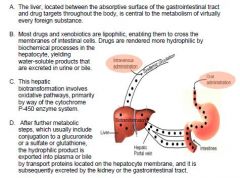![]()
![]()
![]()
Use LEFT and RIGHT arrow keys to navigate between flashcards;
Use UP and DOWN arrow keys to flip the card;
H to show hint;
A reads text to speech;
10 Cards in this Set
- Front
- Back
|
Biotransformation
|

|
|
|
Mechanisms of drug-induced liver disease:Disruption of intracellular calcium homeostasis
|
Disruption of intracellular calcium homeostasis leads to the disassembly of actin fibrils at the surface of the hepatocyte, resulting in blebbing of the cell membrane, rupture, and cell lysis.
|
|
|
Mechanisms of drug-induced liver disease: cholestatic diseases,
|
In cholestatic diseases, disruption of actin filaments may occur next to the canaliculus, the specialized portion of the cell responsible for bile excretion.
Loss of villous processes and the interruption of transport pumps such as multidrug-resistance–associated protein 3 (MRP3) prevent the excretion of bilirubin and other organic compounds. Drugs that affect transport proteins at the canalicular membrane can interrupt bile flow. |
|
|
Mechanisms of drug-induced liver disease: heme-containing cytochrome
|
Many hepatocellular reactions involve the heme-containing cytochrome P-450 system, generating high-energy reactions that can lead to the covalent binding of drug to enzyme, thus creating new, nonfunctioning adducts.
|
|
|
Mechanisms of drug-induced liver disease: Covalent bonded drugs to liver enzyme
|
These enzyme–drug adducts migrate to the cell surface in vesicles to serve as target immunogens for cytolytic attack by T cells, stimulating a multifaceted immune response involving both cytolytic T cells and cytokines. The secondary cytokine response thus evoked may cause inflammation and additional neutrophil-mediated hepatotoxicity.
|
|
|
Mechanisms of drug-induced liver disease: Apoptotic pathways
|
Activation of apoptotic pathways by TNF-α receptor or Fas may trigger the cascade of intercellular caspases, which results in programmed cell death with loss of nuclear chromatin.
|
|
|
Mechanisms of drug-induced liver disease: Respiratory chain enzymes
|
When drugs bind to or otherwise disable respiratory-chain enzymes or mitochondrial DNA, oxidative stress results, with ensuing anaerobic metabolism, lactic acidosis, and triglyceride accumulation (microvesicular fat within cells). Steatohepatitis (fat that primarily accumulates in the large vesicles outside the liver cells, with associated inflammation) is commonly associated with alcohol abuse, but it may also result from drugs.
|
|
|
Susceptibility for hepatotoxicity
|
1. Adults > children; women > men
2. Obesity and malnutrition Malnutrition may deplete glutathione 3. Pregnancy, concomitantly administered medications (e.g., enzyme inducers), and a history of drug reactions 4. Preexisting liver disease and coexisting illnesses have a greater effect on the ability of the patient to recover from liver injury than on the likelihood that it will develop. 5. The most important susceptibility factor for hepatotoxicity is genetic variability. Genetic polymorphisms have a strong influence on drug metabolism and may increase risk. For example, polymorphism of the N-acetyltransferase 2 gene differentiates fast from slow acetylators; the latter have increased susceptibility to isoniazid toxicity. |
|
|
Acetaminophen
1. Significance |
a. Acetaminophen toxicity produces the most common form of acute liver failure in the United States, accounting for 39% of cases.
b. This type of liver injury occurs both after attempted suicide by acetaminophen overdose and after unintentional “therapeutic misadventures,” in which use of the drug for pain relief in excess of the dose specified in the package labeling typically occurs over a period of several days. |
|
|
Acetaminophen--Mech
|
****, just read it...its like a book
|

